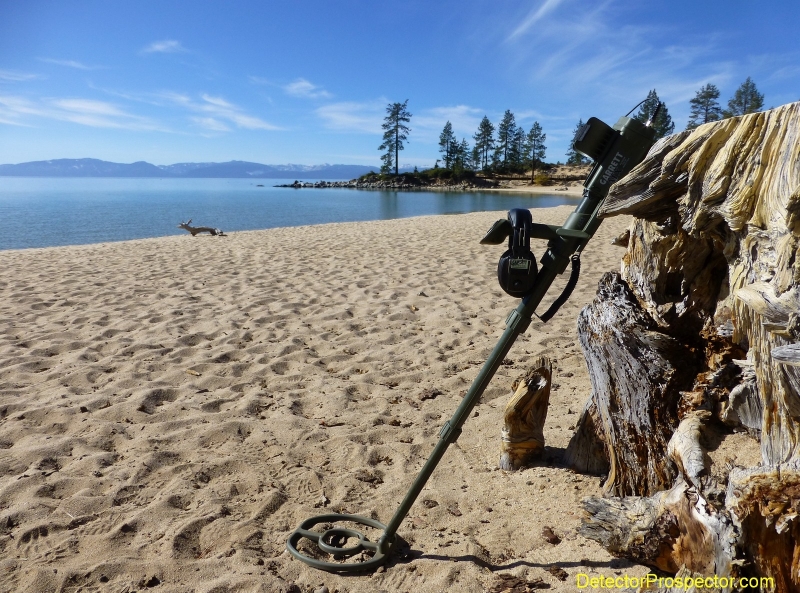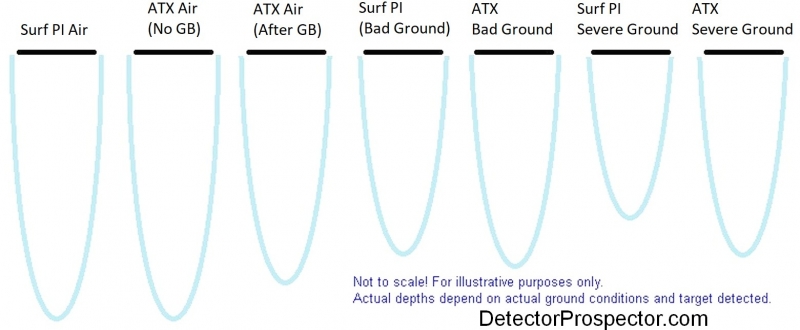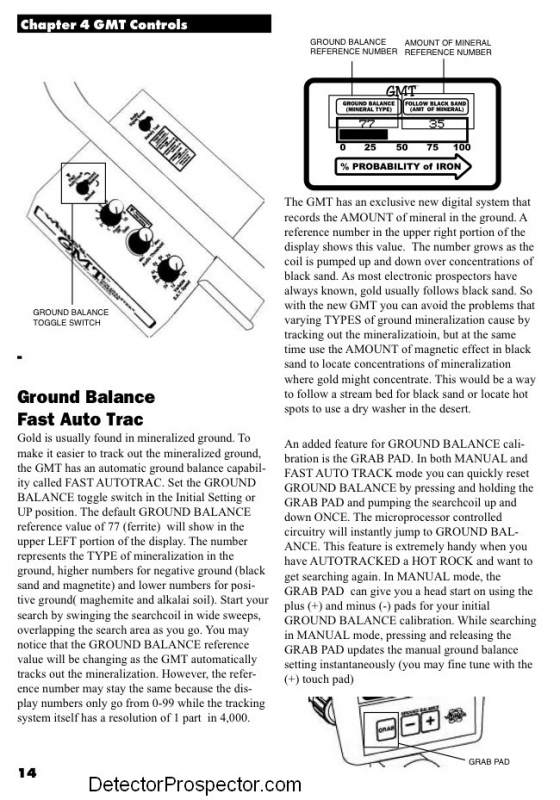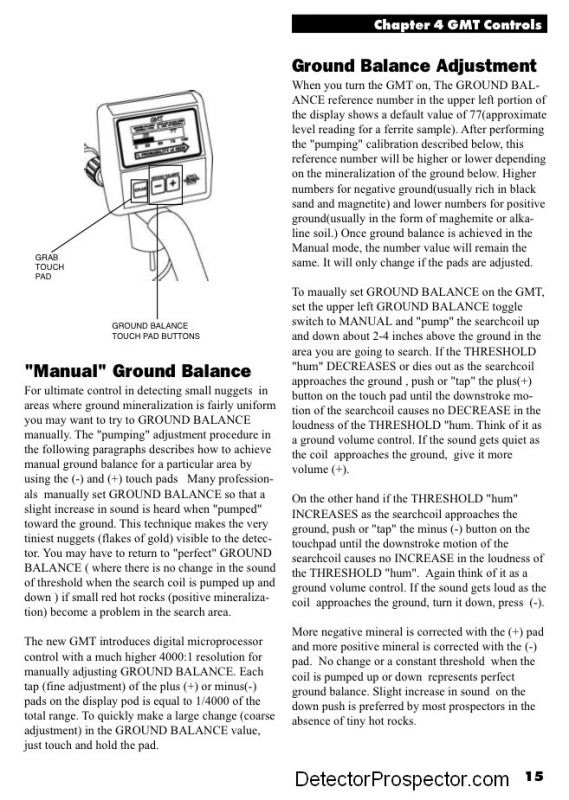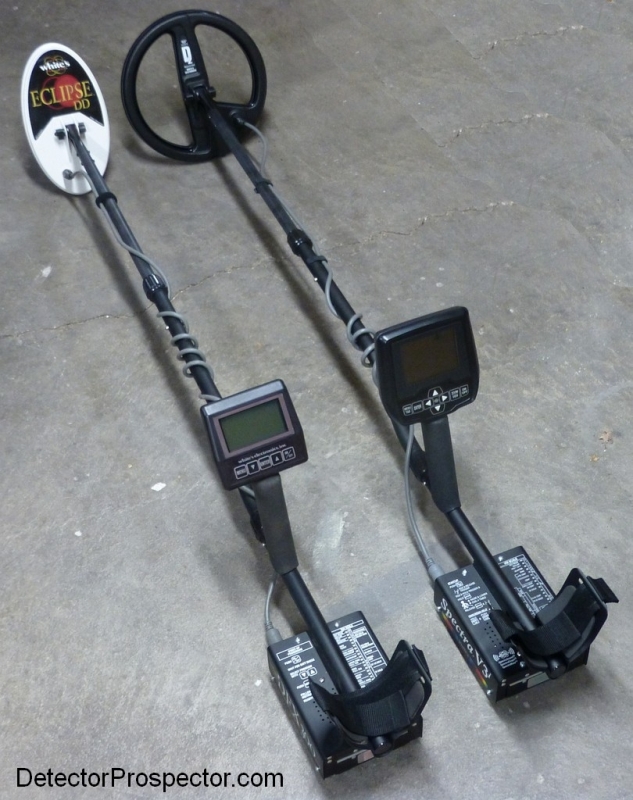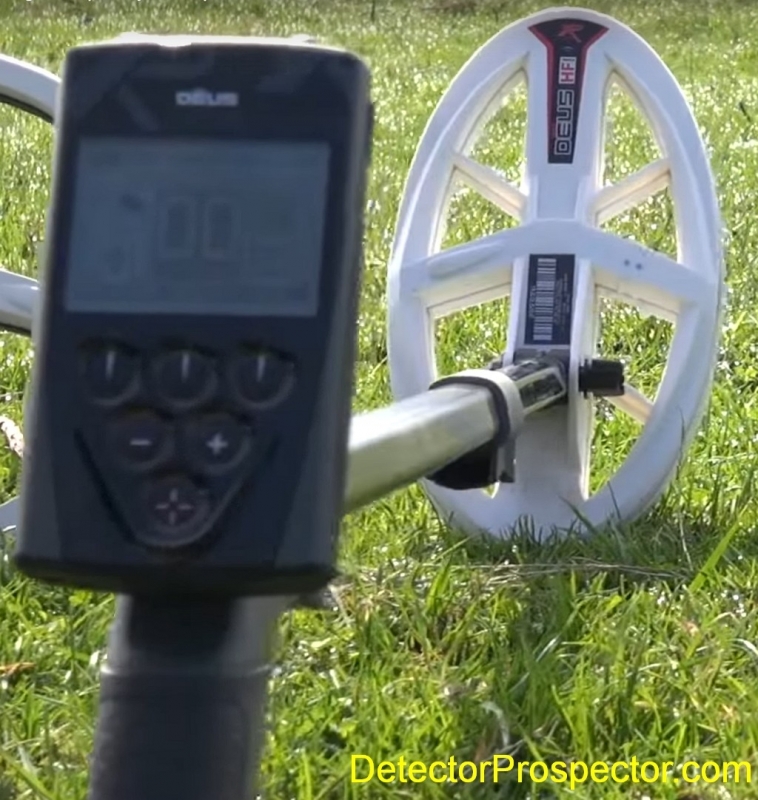-
Posts
19,802 -
Joined
Content Type
Forums
Detector Prospector Home
Detector Database
Downloads
Everything posted by Steve Herschbach
-

What You Need To Know About The Scuba Tector
Steve Herschbach replied to Ridge Runner's topic in Quest Metal Detectors
Here is the video.... I can't say I am surprised. This is a PI pinpointer set to ignore salt water, so gold sensitivity would be impacted. Still, it looks worse than one would expect. It hits rings better simply because a ring in a loop of metal. Any ring like item (steel washer) with produce a better signal with a metal detector because they create a good circular path for eddy currents by essentially mimicking the loop of metal in your metal detector searchcoil. Chains on the other hand are notoriously hard to detect because of the loose connection between links. A detector is more prone to seeing each link as a separate item than a continuous mass, making detection difficult. Why Won't My Detector Find A Bottle Full Of Small Nuggets? Or A Gold Chain? -

Keene Mini Max
Steve Herschbach replied to Triplehooked's topic in Gold Panning, Sluicing, Dredging, Drywashing, Etc
Each of those little 500gph bilge pumps draws about 2 amps. A good deep cycle battery should give you about 20 - 25 hours running time. Great little unit, just a modified A52 sluice. The only catch is with the small GPM delivered by the bilge pumps you have to baby the feed compared to what you can do with the same sluice using a good stream flow to supply the water. -
When I created the Metal Detecting & Prospecting Classifieds the forum was smaller and less busy. I set it up initially so that any forum member can post in the Classifieds. So far that has worked well, or at least I have had no complaints. However, I am seeing a definite uptick in the number of people who join the forum for the sole purpose of placing an ad. This is in theory a good thing - new forum members! Unfortunately it does mean people with no forum history at all can place an ad one minute after joining, and that invites scammers. I have therefore just added a provision whereby only forum members who have made at least two posts on other forums can place an ad in the Classifieds. This is a free service intended for forum members in good standing, and a benefit for active, posting members. That provides for at least a minimal level of protection from someone trying to scam other forum members. I will generally be able to spot people who join and make a couple worthless posts for no other reason than to bump the count to place an ad. Anyway, this is kind of provisional, and I can remove the requirement, or make it more difficult by raising the post requirement even higher. The bottom line is if everyone is very careful to properly vet potential purchases this is not necessary, but I do worry a bit about somebody being taken advantage of and want to do what is reasonable to try and prevent that without being too draconian. Am I being to paranoid? Everyone comfortable with it the way it has been? Or is a post limit a good idea? Thoughts, opinions, feedback?
-
The ATX will work for you just fine in Florida but I just would not expect any real depth advantage, if any, over the Surf PI. The noise at the end of swings is normal if the machine is picking up the salt - it is worse walking parallel to shore and reduced if you walk straight to the water and then straight away. So work the beach up and down instead of side to side, if you know what I mean. It is possible to not ground balance the ATX and run sensitivity high, but you have to use careful coil control to manage the undesired sounds. One advantage with an ATX is the tones can sometimes be used to advantage, as can the iron disc for shallow ferrous items like bobby pins. The entire reason for a ground balancing PI (GBPI) however is in the advantage ground balancing offers in real bad ground. You just happen to be in one of the few locations in the world where magnetic ground mineralization is rare to nonexistent. So yeah, I am a huge ATX fan but if I was headed to Florida tomorrow I would be packing my CTX.
-

What's Your Pleasure In Batteries
Steve Herschbach replied to Ridge Runner's topic in Metal Detector Advice & Comparisons
I am guessing most of us got burned by Ni-Cad batteries. I don't know how many of them were going to save me money, but got tossed as going bad on the shelf over the winter or whatever. My DFX right now has a White's Ni-Cad system that is pretty much useless the life is so short. I use the standard AA pack and use separate rechargeable NiMH batteries instead. There is a lot to be said for going that way as I can toss and replace individual cells as they go bad. New battery systems are far better now and I am finally starting to trust them more. I think most normal detectorists can do just fine now with built in rechargeable batteries like what we see in the Deus. Use detector by day, charge at night. Prospecting however involves remote locations, sometimes for long periods, and running your detector dead is no good unless you can slap another battery pack in and get on with business. My GPZ pretty much runs all day and gets charged each night, but I would not be comfortable without that spare battery in my kit - just in case. I lean a bit more to the White's style drop in battery as opposed to the Minelab clip on battery, simply because the White's system protects the expensive battery more. Something like a waterproof detector however does really benefit from a built in sealed battery. The best part will be when wireless charging comes to detectors, eliminating the need for a charger connection. This would help make waterproof detectors less leak prone. -
Great stuff Harry congratulations! Any story here at all? Was this something you researched in advance, anticipated, hunted down and found? Or more just a lucky find while doing the general detecting thing? Gold Bug 2? Thanks for posting!
-
Welcome to the forum! First off, your mention of "drift" does not seem right - you may have a defective detector. Drift in my book means you tune up the detector, and if you leave it sitting on the ground and walk away, the tuning slowly changes all by itself. This is usually seen by the threshold getting slowly louder until it becomes very loud. Or, the threshold fades away until it disappears. Any modern detector operating properly should hold a steady threshold after tuning. Now, if you are tuning up your machine in one spot, then when you move it it starts to make sounds, then the detector may simply not be tuned properly. For starters, your sensitivity level may be too high for salt water operation. Florida generally has a higher salinity level than some other places and so the salt water itself is a problem, though the ATX should still ground balance it out. If you read the link posted above however you will see it takes me a combination of lower sensitivity, increased disc, and ground balancing to tame the salt water and volcanic rocks in Hawaii. The first goal is to get stable operation. I have a very hard time explaining to people that PI detectors in particular and ground balancing in general do not "add depth" or "go deeper". Due to the point of diminishing returns the fact is most good high power metal detectors with an identical coil will find a metal object in an air test at roughly the same distance. This is the theoretical 100% max depth as revealed in air tests. It is the theoretical maximum distance into the ground that you might find the same item in the ground. The problem is metal detectors also pick up both magnetic type soils and salt water. If the detector is seeing these things it blinds them to the metal object you wish to find. The classic example is car headlights in the dark. When the air is clear you can use high beams and see a great distance. However, if the air is full of heavy rain or snow, the headlights reflect off these undesired targets and blind the driver. The solution? Low beams. Less power focused more directly in front of the car removes the excess feedback from the rain/snow allowing you to see that deer standing in the road. Ground balancing is a filter and not all that different that the way the discrimination system works. The ground signal or salt signal (or both) are identified and then tuned out. The ground effect is still there, but the detector subtracts it from the overall signal. The key word there is "subtracts". Ground balance methods work by subtracting part of the signal, and all subtractive methods create depth losses of some sort the closer any detected item gets to the "hole" created by subtracting the ground or salt signal. Signals are not perfect but spread over a small range, and so eliminating any signal usually means taking out a small range of signals. If you have a trash target like a bottle cap and a high resolution detector that bottle cap will produce a VDI (Visual Display Indicator) number or target id number. If you try to disc just that one number, you will still usually get a broken signal, because the bottle cap actually produces a small range of numbers that dance around as you sweep the coil over it repeatedly. To reject the bottle cap completely means possibly having to eliminate a range of several VDI numbers. The catch? Any good items with similar numbers will also be rejected along with the bottle cap. Items that read just one or two VDI numbers in either direction may also see degraded results. Ground balance works the same way. A window of response is rejected. Desired tems that fall into or near that same signal response area see reduced depths or are eliminated. Luckily most desired items do not fall into the same region as most ground signals. Eliminating slat signals has more direct impact because small gold signals and salt signals are identical. The ground balance is a filter that is applied to the signal and depending on the efficiency of the method used, there is almost always some degradation of all target signals as compared to a metal detector running in a pure all metal mode with no ground balancing at all as measured in air tests. The White's TDI illustrates this perfectly. Turn of the ground balance and air test a nickel. No simply turn on the ground balance, and air test the same nickel. There will be an immediate loss of depth simply by engaging the ground balance filter. The amount of dpeth lost will vary depending where the ground balance control is set. The closer to the nickel reading the ground balance setting gets, the weaker the signal on the nickel itself. Normally a ground balance gets set to whatever the ground demands, but in low mineral ground there is a lot of leeway, and knowing which way to go with the ground balance control on the TDI can enhance certain signals and degrade others. Sorry for the long winded explanation but this is hard stuff to get across in words. For the grand finale consider the White's Surf PI Dual Field and the ATX. The Surf PI does not ground balance at all. The ATX does ground balance, but immediately after a factory reset the filter is at the minimum level or as close to neutral as possible, although I do not think it can be considered to be completely off. But for the purposes of this discussion let's assume that is the case. In the diagram above: 1. Surf PI Air and ATX Air (No GB) - here we are assuming we have found an item that the Surf PI and ATX with no ground balance applied both see at identical distance in an air test. Both units are seing 100%. 2. ATX Air (After GB) - now we ground balance the ATX and air test our item again. We note that after ground balancing the very same item cannot be detected as far in an air test as before ground balancing. This is because the filtering effect has removed some depth. In this case if detecting in pure white sand, little or no mineralization, the Surf PI will get more depth that a ground balanced ATX. In very low mineral ground, like in Florida, the ATX will perform best with no ground balancing. Now, from a practical perspective when dealing with salt water you have a problem. The Surf PI is a pure PI detector with a pulse delay specifically chosen to ignore salt water effects. The machine is inherently insensitive to salt signals and small gold. The ATX is much hotter on small gold, and so will pick up salt water easily. This means that just to get in saltwater you have to lower the sensitivity, or increase the disc setting, or ground balance the ATX to the salt water, or some combination of the three. So while in theory the ATX is hotter on small gold than the Surf PI, just to get in saltwater you have to engage filters to bring the ATX small gold sensitivity down to Surf PI levels so as to ignore the salt signal. 3. Surf PI (Bad Ground) and ATX (Bad Ground) - Now we are on a beach that has quite a bit of darker soil content along with some magnetic soil properties. The Surf PI has no ability to ground balance or tune out this soil, and so it is getting lots of ground signals. The only way the machine can cope is lower receiver sensitivity or increased pulse delay, which lowers sensitivity a different way, plus careful coil control. Quite a bit of dpeth is lost. Note the ATX also loses depth in this scenario, but because the detector can be ground balanced, it does not lose as much depth. Let me repeat that, it is so important. The ATX succeeds here, not by going deeper, but by losing less depth. This is a critical difference in how people think about metal detectors. people always think in terms of "getting more depth" when a more accurate way to think about it is to think in terms of "losing less depth" as compared to air test theoretical 100% maximums. It is not the detector that gets the most depth that wins, but the detector that loses the least depth. This may seem like two ways to say the same thing but it is not. It is why I tend to have so little regard for air tests. Air tests do have value in showing what could be the max 100% depth an item can be found at in perfect conditions. However, what is far more important is how much of that depth is retained under adverse conditions, i.e. in the ground or in salt water. Anybody can make a detector that air tests great. The Surf PI is a simple easy to make in your garage circuit and it air tests fine. Yet it will not do as a gold prospecting detector since it completely lacks any ability to ground balance and so gives up nearly all ites performance in extremely mineralized ground. Which brings us to... 4. Surf PI (Severe Ground) and ATX (Severe Ground) - I am actually being too generous with the Surf PI here as in bad ground it could be running at 50% or less of its theoretical max obtainable air test on a buried item in severe ground, with the ATX getting under to double or more depth that the Surf. Yet do note that the ATX has lost depth also - it just does not lose the depth as quickly or as severely because it has the ground balance circuit working for it hard, trying to retain depth under adverse conditions. The Surf I under such conditions is at distinct disadvantage. So, two detectors, the Surf PI (pure PI) and ATX (Ground Balancing PI). The less mineral content in the ground, the better the Surf PI looks, and so Florida, especially the Florida Keys, is the ideal situation for the Surf PI since Florida soil runs from very low to almost zero magnetic mineral content. The ATX looks better and better by comparison as ground mineralization increases. West coast and especially Oregon and Washington type black sand salt water beaches are the ground that suits the ATX best. Not because it gets more depth than the Surf PI, but because the ATX will lose far less depth under those conditions when properly ground balanced. I hope this helps as it is a difficult subject to communicate.
-

White's Dfx Versus V3i On Gold
Steve Herschbach replied to Steve Herschbach's topic in White's Metal Detectors
I have extreme respect for teachers (my wife is one) so that is a high compliment indeed. Thank you sir! -

White's Dfx Versus V3i On Gold
Steve Herschbach replied to Steve Herschbach's topic in White's Metal Detectors
The Prospecting Scan (Alluvial Scan) is, as far as I can tell, a continuous graphic display of the ground phase which is the same thing as a ground balance setting. It is showing you the TYPE or ground mineralization, not the AMOUNT of ground mineral. See here for reference. Low numbers are salt ground and higher numbers ferrous ground. In theory tracking to more mineralized ground looking for black sand concentrations, on the theory those concentrations will have gold associated. The reality is this function in a normal metal detector is so depth limited that it is debatable whether eyeballs looking for color variations might be the better tool. -

White's Dfx Versus V3i On Gold
Steve Herschbach replied to Steve Herschbach's topic in White's Metal Detectors
We are all learning here! What makes true manual ground balance different is that the control simply spans the entire available ground balance range. This range does vary a lot in detectors. Anyway, you just put the control where you want, and most owner manuals tell you a good default setting. The only way to properly ground balance a manual unit is to manipulate the control in reference to audio feedback you get when bouncing the coil about 8-12" over the ground. Some places have no magnetic ground content (Florida white sand beach) against which to ground balance, so you dial in the default value instead. At a certain level metal detector targets exist in reference to and in opposition to the ground balance setting. Performance degrades as the target VDI (phase) gets closer to the ground balance VDI (phase). In some circumstances you can purposefully move the ground balance setting away from the targets electronic reading and enhance the target signal by doing so. The White's TDI, even though it is a PI, is a machine that demonstrates well the effect of ground balance on desireable targets. Another oddball use - splitting the difference between the ground balance setting for the ground itself, and a particular pesky hot rock. A person can usually operate with a bit of positive offset anyway. Moving the ground balance point closer to where a hot rock reads and away from the ground will increase ground noise but decrease the intensity of the hot rock "hit". Lower Gain, increased SAT, and splitting the GB setting can all help make hot rocks less obtrusive or even eliminate them entirely. Long story short, there are reasons to manually mess with the ground balance. -

White's Dfx Versus V3i On Gold
Steve Herschbach replied to Steve Herschbach's topic in White's Metal Detectors
Welcome to the V3i rabbit hole! Yeah, track speed, SAT, recovery speed, filters - all matter and interact. -

White's Dfx Versus V3i On Gold
Steve Herschbach replied to Steve Herschbach's topic in White's Metal Detectors
The last few posts I made give some examples of why a manual offset either positive or negative is sometimes desirable as opposed to a "perfect" ground balance. Tracking or even ground grab gives you what the engineers think is the best ground balance. However, when prospecting I usually run slightly positive. If I ground grab a Gold Bug Pro, I get a neutral ground balance. But the first thing I do is hit the manual + button twice, which makes the detector give a slight response as the coil approaches the ground, my desired setting. It may be the V3i in Locktrac but punched up 1 or 2 points via the offset will produce better results on the tiniest gold targets. -

White's Dfx Versus V3i On Gold
Steve Herschbach replied to Steve Herschbach's topic in White's Metal Detectors
V3i does have a track speed setting. Owners Manual page 34: "Speed – Selects the speed or aggression of Auto Tracking. Press ARROW Left & Right to select the speed of Auto Tracking. Excessive ground tracking can be as bad for performance as insufficient ground tracking. A speed that keeps up with progressive ground changes is desired. A setting that adjusts significantly when passing over slight (spotty) ground imperfections can cause instability and errors. Ideally select a speed that keeps up, yet doesn’t overcompensate for every unusual rock." Part of the problem is this is a multi frequency detector and so ground tracking is probably a much more complicated thing than it is with a single frequency detector. Plus, the GMT and MXT have a specific prospecting intent, whereas with the V3i prospecting was probably last on the engineer "worry list". Also from Link deleted since Findmall Forum update broke all old links "Tracking Speed, lower numbers equals slower track speed. The V is always tracking as long as auto track is on. The control adjusts the limit of how much it can track at one time. So, (example - numbers are not correct at all - just to give you an idea what's going on), say you have a ground signal that is off by 10000 from where ground really is. If you have your setting at 10, the detector would track at the most by 20 at one sample. If your ground was off by only 8, then it would adjust by 8 as that's less than the limit. But at 10000, it will be limited to 10 at that one data sample. Whereas, a setting of 20 will track at most by 40 per data sample. There are a lot of factors that come into play on how tracking is adjusted - whether it has seen a target recently, how fast the ground is changing, the user adjustable track speed, how close the ground setting is to the current ground. If the ground setting is close to the current ground, it will track to the current ground faster than if the current reading is far away (might be a target and don't want to track to targets)." -

White's Dfx Versus V3i On Gold
Steve Herschbach replied to Steve Herschbach's topic in White's Metal Detectors
I see that White's describes the "ground grab" method in the V3i manual as being "Manual Ground Balance" so you have your proof there! I guess it is a manual method compared to tracking but it is still a ground grab methodology. The GMT for a long time was my only and best example of a detector that does all three basic methods. 1. Tracking 2. Ground Grab (or Track & Lock) 3. Manual and for sake of accuracy a fourth method exists.... 4. Factory Pre-Set Click images for larger versions.... -

White's Dfx Versus V3i On Gold
Steve Herschbach replied to Steve Herschbach's topic in White's Metal Detectors
The V3i is a bit unique as it basically offers either automatic ground tracking and a "track & lock" or ground grab system. However, since White's removed the DFX manual ground balance (G.E.B.) settings from the V3i, they did see fit to add a "Lock Offset" function. Some automatic tracking systems (like DFX and V3i) feature a "Track Offset" function that allows you to create a positive or negative bias to be applied to the tracking results. V3i added a "Lock Offset" which is basically a manual ground balance control. The difference is it gets the base setting via the ground grab, and then just adjusts up or down from there. "Offset – Selects a slightly + or – ground balance and tracking setting point to enhance ground rejectionand target responses. Typically a “+” offset is used to reduce ground mineral responses and enhance target signal responses (particularly small size targets) in extreme ground types. More rarely “-“ offset may be used to enhance the response of iron oxides in a low iron ground matrix, for example stony iron meteorites in a ground matrix consisting of ice/snow." -

White's Dfx Versus V3i On Gold
Steve Herschbach replied to Steve Herschbach's topic in White's Metal Detectors
Basically, no. The DFX has a D.C. Phase function and the V3i the Ground Probe, but neither is as simple as say the Gold Bug Pro in all metal mode, where the big number on screen is a live ground phase number. -

White's Dfx Versus V3i On Gold
Steve Herschbach replied to Steve Herschbach's topic in White's Metal Detectors
Deft Tones, this is all no big deal, just me "self teaching" by looking up stuff for my own use and then posting about it. Manual ground balance is rarely needed by most people but is firmly entrenched in the prospecting world. In the end, all metal detector performance comes down to the efficiency and accuracy of the ground balance. A fine manual tune was once considered essential for gold prospecting but honestly that is not so true any longer as better tracking systems come online. -

White's Dfx Versus V3i On Gold
Steve Herschbach replied to Steve Herschbach's topic in White's Metal Detectors
The old MXT was of course just tracking or "track and lock". The addition of the ground grab button on later MXTs was a nice usability enhancement but really does the same thing in the end. -

White's Dfx Versus V3i On Gold
Steve Herschbach replied to Steve Herschbach's topic in White's Metal Detectors
That's correct John. I think we are thinking same thing and tripping over terminology. The F75, GBP, etc. track internally and display the current tracking as the ground phase number. This is only displayed however and is not engaged or used until locked in via the ground grab button. -

White's Dfx Versus V3i On Gold
Steve Herschbach replied to Steve Herschbach's topic in White's Metal Detectors
No, that is ground grab. Manual ground balance has the ability to adjust up or down via a control. There are three basic methods: GMT - Ground tracking OR ground grab OR manual ground balance MXT - Ground tracking OR ground grab V3i - Ground tracking OR ground grab With automatic tracking a detector adjusts to the ground on the fly. Ground grab is accomplished via either the "track and lock method" or via a "Ground Grab" button. Tracking and then locking simply sets the balance at the last tracked setting. Ground grab usually relies on a detector tracking internally and then "grabbing" whatever that internally tracked number is and locking it into place via a button or switch. Machines like the F75 and Gold Bug Pro, to name a couple, do track internally at all times, which is where the ground phase display comes from. Hitting the ground grab button on either unit locks the current tracked number in as the current fixed ground balance setting. Other machines ground grab by temporarily engaging a tracking circuit when a button or switch is activated. Manual ground balance is pure manual control. Classic example is the Gold Bug 2 ground balance (ground reject) knob. -
I have been bouncing back and forth between the White's DFX and V3i for many years. In theory the switch to V3i should be a no-brainer. However, the original Vision model I got had bad EMI issues in Anchorage, Alaska, especially with buried power lines. When the V3i came out I tried again with no joy. When I moved to Reno I tried again, and EMI was less a problem. The next issue is the main reason I have a DFX is to run a BigFoot coil. Most coils need to be tuned for the specific detector operating frequency. The BigFoot is tuned for 3 kHz and 15 kHz especially for the MXT/DFX series. My BigFoot works well enough in V3i 2.5 kHz and 7.5 kHz single frequency modes. However, in 22.5 kHz single frequency mode or in three frequency mode the target id (VDI) numbers all skew very high (they tripled on the last V3i that I had). This more or less limited the BigFoot to being used only in 7.5 kHz mode on the V3i where I would generally prefer to use 22.5 kHz single frequency mode. The coil runs just fine on the DFX in 15 kHz mode so after lots of back and forth I finally settled on the DFX. The DFX has weaknesses however. The DFX always transmits a combined dual frequency waveform. When single frequency mode is chosen, the machine still transmits the same waveform optimized for dual frequency use, but simply ignores half the return signal to process either the 3 kHz portion or the 15 kHz portion. The transmit waveform is not optimized for single frequency and so some punch is lost compared to a dedicated single frequency machine like the MXT. The V3i in single frequency mode actually modifies the transmit waveform for use at the single frequency. It is still not quite as efficient as a dedicated single frequency detector, but a big improvement over the DFX way of doing things. The V3i also adds transmit boost capability, that can bring that last little bit of lost performance as compared to a dedicated single frequency detector. The lost efficiency shows up more as shorter battery life than actual lost performance. Second, the DFX while in multi frequency mode is always locked into "Salt Mode" for saltwater beach operation, effectively tuning out the salt range. This unfortunately means that small gold capability is degraded in DFX dual frequency mode. The V3i allows the salt mode operation to be deactivated while in multi frequency mode, allowing for better small gold performance while in MF mode. The closest the DFX can get is to run in a single frequency mode, which turns off the dual frequency salt compensation. But now you are back to running a less optimized single frequency mode as compared to the V3i in single frequency mode. Long story short there are too many benefits and neat features on the V3i that I have been denying myself due to my desire for BigFoot compatibility. The fact is I normally run the BigFoot in 15 kHz single frequency mode on my DFX for a little extra gold hots. However, after some thought I have decided the V3i running at an optimized 7.5 kHz is likely just as good if not better than the DFX running a "soft" 15 kHz. So I did talk myself into a new V3i recently. In theory the V3i at 22.5 kHz should be a decent nugget detector, but you rarely hear of it being used as such. Part of that is a ground balance issue. The DFX and V3i tracking systems really are not up to working that well in heavily mineralized ground. The DFX does offer a normal manual ground balance mode with both a coarse and fine adjust, although you have to dive into the menu to access it - not so handy for making constant tweaks. The V3i actually has no true Manual ground balance mode. The best you can do is track and lock, as on the MXT. However, the V3i "Live Controls" can be set up to give the operator direct access to a ground balance offset that can tweak the "locked" setting up or down. That may actually be easier to access and use than the DFX version of manual ground balance but I need to play around more to find out for sure. White's DFX and White's V3i metal detectors
-

XP Deus HF Elliptical Coil Delayed Until July?
Steve Herschbach replied to Ono's topic in XP Metal Detectors
I expect I will have one of these coils next week so we will see. I can't imagine XP releasing a complete loser of a coil. Now the guy reporting the poor depth says "never mind"! http://www.treasurenet.com/forums/deus/546676-first-thoughts-review-new-xp-deus-elliptical-coil-5.html#post5464355 -
I run in auto a lot and when doing so I just leave it there with no ill effects, but switching to Manual 10 might give you a sharper signal for pinpointing small nuggets.
-

XP Deus HF Elliptical Coil Delayed Until July?
Steve Herschbach replied to Ono's topic in XP Metal Detectors
Part of my desire for this coil is that it perhaps does not beat a Gold Bug 2 but is close enough to do the trick, given it can be used to coin, jewelry, and relic hunt. But if it does well on gold but not well enough on coins etc. then you are back to needing at least two detectors (or at least two Deus coils) to get a good balance in performance. The 9" round HF coil may be the better compromise, with the elliptical tilted too heavily to the gold nugget side of the equation.

